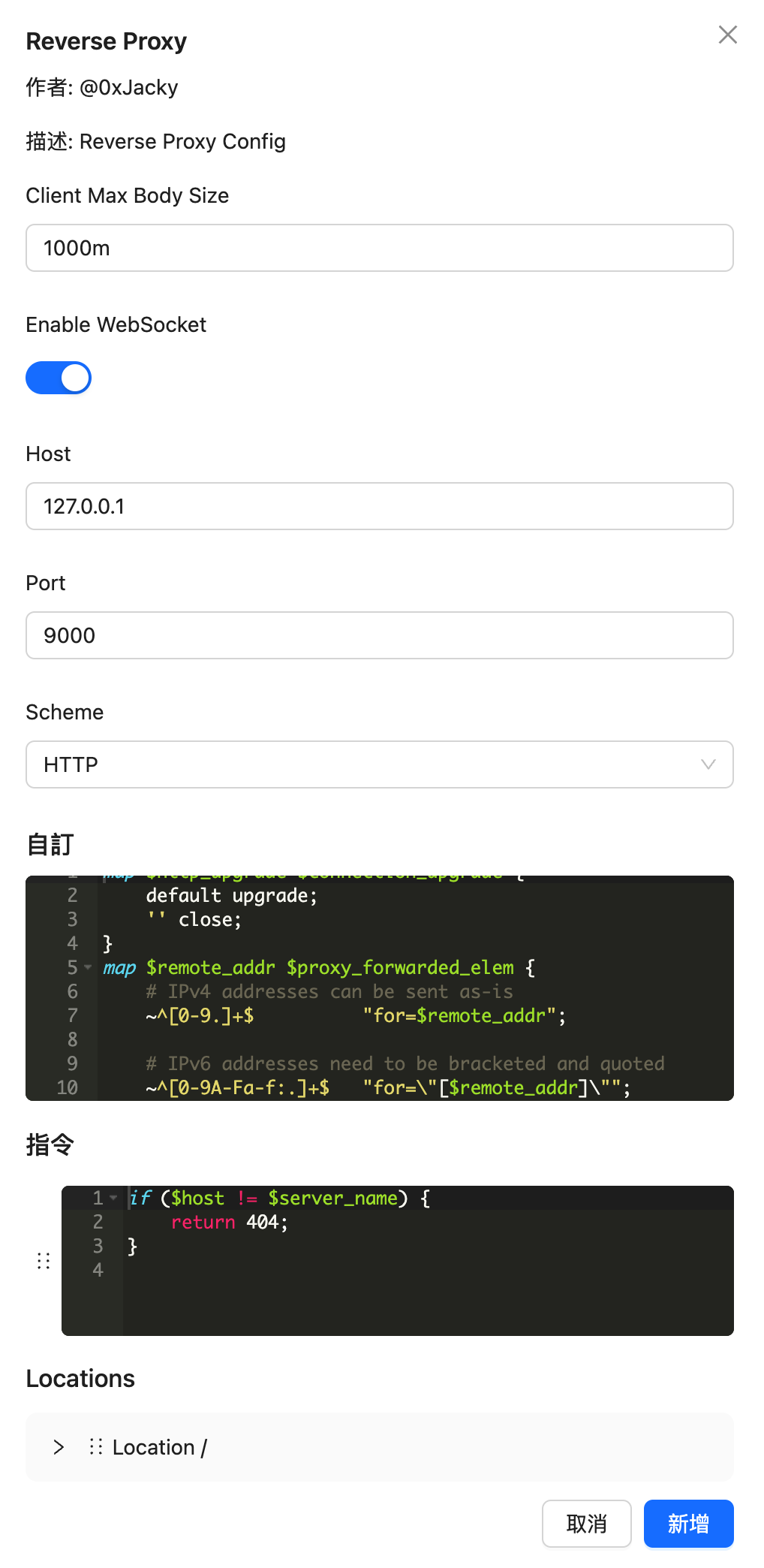設定範本
Nginx UI Template 提供了一種開箱即用的設定範本機制。在 NgxConfigEditor 中,我們設計了一個視覺化介面,使使用者能夠方便地將範本中的設定插入到目前的設定檔中。 在本指南中,我們將介紹這種設定範本的文件格式和語法規則。 設定範本文件儲存在 template/block 目錄中,我們歡迎並期待您透過提交 PR 的形式分享您編寫的設定範本。
TIP
請注意,每次修改或新增設定檔後,需要重新編譯後端以生效。
文件格式
Nginx UI Template 文件由兩部分組成:文件頭部以及具體的 Nginx 設定。
以下是一個關於反向代理的設定範本,我們將以此範本為基礎向您介紹 Nginx UI Template 的文件格式及相關語法。
# Nginx UI Template Start
name = "Reverse Proxy"
author = "@0xJacky"
description = { en = "Reverse Proxy Config", zh_CN = "反向代理設定"}
[variables.enableWebSocket]
type = "boolean"
name = { en = "Enable WebSocket", zh_CN = "啟用 WebSocket"}
value = true
[variables.clientMaxBodySize]
type = "string"
name = { en = "Client Max Body Size", zh_CN = "客戶端最大請求內容大小"}
value = "1000m"
[variables.scheme]
type = "select"
name = { en = "Scheme", zh_CN = "協議"}
value = "http"
mask = { http = { en = "HTTP" }, https = { en = "HTTPS" } }
[variables.host]
type = "string"
name = { en = "Host", zh_CN = "主機"}
value = "127.0.0.1"
[variables.port]
type = "string"
name = { en = "Port", zh_CN = "連接埠"}
value = 9000
# Nginx UI Template End
# Nginx UI Custom Start
{{- if .enableWebSocket }}
map $http_upgrade $connection_upgrade {
default upgrade;
'' close;
}
{{- end }}
# Nginx UI Custom End
if ($host != $server_name) {
return 404;
}
location / {
{{ if .enableWebSocket }}
proxy_http_version 1.1;
proxy_set_header Upgrade $http_upgrade;
proxy_set_header Connection $connection_upgrade;
{{ end }}
client_max_body_size {{ .clientMaxBodySize }};
proxy_redirect off;
proxy_set_header Host $host;
proxy_set_header X-Real-IP $remote_addr;
proxy_set_header X-Forwarded-For $proxy_add_x_forwarded_for;
proxy_set_header X-Forwarded-Proto $scheme;
proxy_pass {{ .scheme }}://{{ .host }}:{{ .port }}/;
}文件頭部
文件頭部應包含在 # Nginx UI Template Start 和 # Nginx UI Template End 之間,並遵循 toml 語法。
文件頭部包含以下欄位:
| 欄位 | 描述 | 類型 | 必要 |
|---|---|---|---|
name | 設定的名稱 | string | 是 |
author | 作者 | string | 是 |
description | 描述,使用 toml 格式的字典來實現多語言描述 | toml 字典 | 是 |
variables.變數名稱.type | 變數類型,目前支援 boolean, string 和 select | string | 是 |
variables.變數名稱.name | 變數顯示的名稱,是一個 toml 格式的字典,用於支援多語言 | toml 字典 | 是 |
variables.變數名稱.value | 變數的預設值 | boolean/string (根據 type 定義) | 否 |
variables.變數名稱.mask | 選擇框的選項 | toml 字典 | 否 |
範例如下:
# Nginx UI Template Start
name = "Reverse Proxy"
author = "@0xJacky"
description = { en = "Reverse Proxy Config", zh_CN = "反向代理設定"}
[variables.enableWebSocket]
type = "boolean"
name = { en = "Enable WebSocket", zh_CN = "啟用 WebSocket"}
value = true
[variables.clientMaxBodySize]
type = "string"
name = { en = "Client Max Body Size", zh_CN = "客戶端最大請求內容大小"}
value = "1000m"
[variables.scheme]
type = "select"
name = { en = "Scheme", zh_CN = "協議"}
value = "http"
mask = { http = { en = "HTTP" }, https = { en = "HTTPS" } }
[variables.host]
type = "string"
name = { en = "Host", zh_CN = "主機"}
value = "127.0.0.1"
[variables.port]
type = "string"
name = { en = "Port", zh_CN = "連接埠"}
value = 9000
# Nginx UI Template End其中,名稱、作者及描述將會以摘要的形式在設定列表中顯示。

當您點選「檢視」按鈕,介面會顯示一個對話框,如下圖所示。

下表展示了變數類型與使用者介面元素的關係:
| 類型 | 使用者介面元素 |
|---|---|
boolean | 開關 |
string | 輸入框 |
select | 選擇框 |
Nginx 設定
Nginx 設定應該在文件頭部之後提供,這部分將使用 Go 的 text/template 涵式庫進行解析。這個涵式庫提供了強大的範本生成能力,包括條件判斷、迴圈以及複雜的文字處理等。 具體語法可以參考 Go 文件。
在頭部中定義的變數可以在這部分中使用,如 .NoneReferer 和 .AllowReferers。請注意,需要預先在頭部定義變數,才能在這部分中使用。
範例如下:
location / {
{{ if .enableWebSocket }}
proxy_http_version 1.1;
proxy_set_header Upgrade $http_upgrade;
proxy_set_header Connection $connection_upgrade;
{{ end }}
client_max_body_size {{ .clientMaxBodySize }};
proxy_redirect off;
proxy_set_header Host $host;
proxy_set_header X-Real-IP $remote_addr;
proxy_set_header X-Forwarded-For $proxy_add_x_forwarded_for;
proxy_set_header X-Forwarded-Proto $scheme;
proxy_set_header Forwarded $proxy_add_forwarded;
proxy_pass {{ .scheme }}://{{ .host }}:{{ .port }}/;
}當使用者修改前端的表單後,系統將會根據使用者的輸入和設定範本自動生成新的設定內容。
除了範本頭部定義的變數,我們還提供了巨集定義的變數,如下表所示:
| 變數名 | 描述 |
|---|---|
| HTTPPORT | Nginx UI 監聽的連接埠 |
| HTTP01PORT | 用於 HTTP01 Challenge 的連接埠 |
上述變數可以直接在設定部分使用,無需在頭部定義。